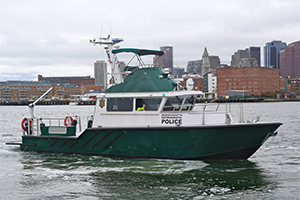From the forward passenger seat of the 50-foot Thomas Paine, Sgt. Eric Baldwin spotted a fishing boat more than a mile away in Massachusetts Bay.
“There’s a contact over there,” said Baldwin, an eight-year veteran of the state Environmental Police. “Let’s get some numbers off of him.”
Baldwin’s partner, Sgt. Michael Powers, throttled up on the vessel’s twin Volvo Penta diesels and quickly caught up with the smaller craft. He pulled alongside the teal-hulled lobster boat, and it was clear the captain was not happy to see them.
“He has a history with us,” Baldwin said after a brief exchange with the man, whose most recent fishing violation was three years earlier. “He’s a little aggravated.”
Enforcing state and federal fishing regulations is one of the Environmental Police’s many roles. Its vessels are used for search and rescue, Homeland Security support, escorting natural-gas tankers into Boston Harbor, targeting drunken boaters, performing safety checks and protecting migrating whales.
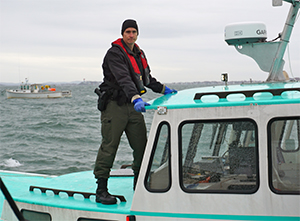 |
|
Environmental Police Officer Scott Opie steadies himself on a lobster boat off Nahant, Mass., before climbing back onto Thomas Paine. Officers had boarded the boat to inspect its catch. |
Thomas Paine is the largest and most powerful patrol boat in the agency’s 80-vessel fleet. MetalCraft Marine of Kingston, Ontario, delivered the boat three years ago using a design developed with aluminum boatbuilder Brunswick. At the time, it was the first commercial vessel in the U.S. with Volvo Penta IPS propulsion, a system previously found only on recreational boats.
At the heart of the system are twin D11 marine diesels producing 510 hp each at 2,250 rpm. The aft-mounted main engines turn twin drives with two forward-facing, counter-rotating propellers. These “pods” are similar to the azimuthing stern drives increasingly found on ship-assist tugboats. The IPS drives rotate 26 degrees on either side of center, giving the vessel much better maneuverability than standard propellers and rudders, Powers said.
The Volvo system has a standard steering wheel as well as joystick controls for close-quarters maneuvering. Powers pulled alongside a downtown Boston pier to demonstrate. With his right hand on the joystick, he guided the vessel sideways against the dock between a fast ferry and an excursion boat. An aft-facing camera that displayed video on a flat-screen TV showed how much room he had at the stern.
“It takes all the skill out of being a boat driver,” said Powers, who joined the agency 24 years ago. “It does all the work for you. There is so much technology on board. What it does is it makes the job easier and safer.”
Thomas Paine can hit 33 knots and it cruises comfortably at 29, even in choppy seas. According to Volvo, the twin 510-hp mains paired with the IPS pods deliver similar performance to 650-hp engines but are 30 percent more fuel-efficient.
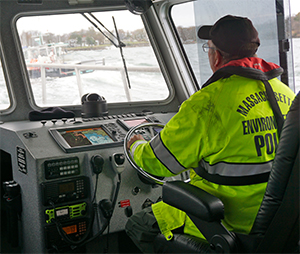 |
|
Sgt. Michael Powers steers the 50-foot patrol boat alongside the fishing vessel. |
Other features on the boat include Furuno navigation electronics, a FLIR infrared camera, nuclear radiation detection, full IT suite, kitchenette and a lower-level berth. Thomas Paine’s high bow also gives officers an elevated perch to climb onto taller vessels.
“This boat is really designed as a boarding platform,” said Powers, who considers the boat’s design and propulsion package “a home run.”
Earlier that morning, Baldwin guided the vessel from its berth in Boston’s Charlestown neighborhood, site of the Battle of Bunker Hill during the Revolutionary War. He steered past the city’s downtown skyscrapers and pulled alongside the Boston Fish Pier, where a handful of fishing boats were tied up. When agency inspectors find an illegal catch, they’ll confiscate it and when possible donate it to local homeless shelters. Other times it’s used for bait.
After duty at the pier, Thomas Paine set off again and entered Boston Harbor, home to 34 small islands. Winds exceeded 15 knots and the seas approached 5 feet on the wet, cold November morning.
“Excuse me, Mike,” Baldwin said to Powers, “but I am going to bring it up.”
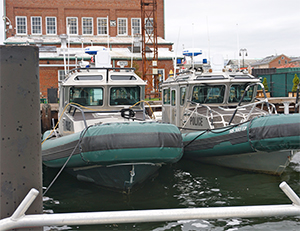 |
|
Massachusetts’ environmental officers have about 80 vessels in use statewide, including these SAFE patrol boats with twin 300-hp outboard engines. |
“Aye aye,” Powers responded.
Within seconds, Thomas Paine accelerated to almost 29 knots. Despite the occasional jostle, it powered through the chop while maintaining speed. The waterway was nearly empty on this morning, but it’s often busy with fishermen and lobster boats coming and going to offload their catch. During the summer, sailboats and powerboats are everywhere, along with local and regional ferries carrying tourists and commuters.
The teal-hulled lobster boat came into view about 15 minutes after Thomas Paine reached Massachusetts Bay. Powers closed the gap between the two boats and Baldwin called in its registration number over the radio. A dispatcher determined its most recent fishing violation came in 2014. Conditions offshore were too rough to board, so Powers followed the vessel into sheltered waters off Nahant.
Baldwin and another officer, four-year veteran Scott Opie, climbed aboard and went to work inspecting the catch. Using a special tool, they check to make sure the lobsters are of legal size. They also check to make sure none of the lobsters are bearing eggs.
Powers pointed the bow into the waves and engaged Thomas Paine’s dynamic positioning (DP) system. It interfaces with a hull-mounted GPS to hold station, even in rough seas. Every few seconds the engines engaged to hold position. Before long, Powers switched from DP to joystick control to stay away from the lobster boat rotating on its mooring.
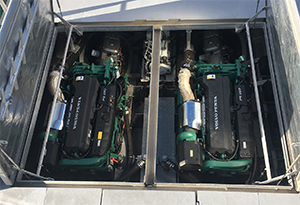 |
|
Thomas Paine, the agency’s largest and most powerful boat, is powered by two 510-hp Volvo Penta engines linked to IPS “pod” drives each turning twin counter-rotating props. It was Volvo Penta’s first commercial IPS installation in the U.S. |
“We’ll stay put,” Powers said, “but he won’t.”
A few minutes later, Baldwin and Opie stepped back onto Thomas Paine. “The guy was legit,” Baldwin said. “There wasn’t a bad lobster in there.”
Powers believes the officers’ presence on the water helps deter bad behavior, whether it’s fisheries violations, drunken boating or trespassers on state-owned islands. Baldwin isn’t so sure. While most fishermen try to follow the rules, he said, others gamble they won’t be caught.
For the next two hours, Thomas Paine made a wide arc back and forth across Massachusetts Bay. The officers traveled south to Hingham, then north to the peninsula town of Hull. From there, they checked for activity on Georges Island, which had closed for the season, and nearby Gallops Island. Both appeared empty.
Baldwin later spotted another lobster boat idling a couple miles offshore. A records check showed the vessel hadn’t been cited for a fisheries violation in more than a decade. The captain showed little emotion as Thomas Paine pulled alongside.
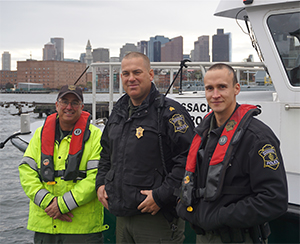 |
|
Sgt. Michael Powers, left, Sgt. Eric Baldwin, center, and Officer Scott Opie take a break on the dock after a morning patrolling Massachusetts Bay. Their duties include port security, search and rescue, vessel inspections and enforcing fisheries regulations. |
Opie and Baldwin boarded the lobster boat as the captain and a deck hand cleaned traps. Powers used the joystick to stay within a few feet of the boat. The lobsters were all legal and the traps passed muster — with a few exceptions. The captain eventually shared a tip about possible illegal fishing by a rogue lobsterman.
Opie, Baldwin and Powers are all assigned to the Environmental Police’s marine unit, but they could be called back to assist with a land-based emergency at any time. Powers recalled a recent morning spent patrolling offshore followed by an afternoon on a four-wheeler searching for a missing person.
Thomas Paine returned to Boston at lunchtime, passing an inbound Reinauer Transportation articulated tug-barge on the way. Powers pulled up to the main container terminal and crept past stacks of shipping crates while the nuclear radiation detector silently scanned for dangerous cargo.
Powers left the container terminal and headed up the Mystic River past the agency’s Charlestown pier. The boat made a quick security check at a liquefied natural gas terminal before turning around and heading home.
The officers planned to spend the afternoon prepping Thomas Paine for winter. With the holiday season approaching, the region’s fishermen would be extremely busy. That meant the Environmental Police would be busy too.

